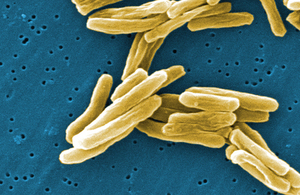Tuberculosis (TB) cases fall by over a third in last 6 years
Buildings across the UK will be illuminated red to mark World TB day 2018.

New Public Health England (PHE) data released for World TB day show a 9.3% decline in cases of TB in 2017. This represents the lowest rate of TB in 35 years. This contributes to the 38% decline in the number of people with TB in England over the last 6 years.
However, there is still more work to do. TB is one of the leading causes of death worldwide and England has one of the highest rates in Western Europe with just under 5,200 people affected by TB in 2017.
To mark World TB Day on 24 March 2018, PHE and its partners are supporting the international Stop TB Partnership and World Health Organisation’s campaign to ‘Light up the World for TB’ and illuminate buildings and landmarks across the world in red. This will occur in various locations over the weekend (23 to 25 March 2018). The activity will highlight the continued focus that is required to meet the ultimate ambition of making England TB-free.
Dr Sarah Anderson, Head of the National TB Office, PHE said:
We are pleased to announce that we have seen a 9.3% fall in TB cases in the last year. This continues the declining trend of the last 6 years and is the lowest rate of TB we have seen in 35 years.
People often think that TB is a Victorian disease that is no longer a problem in England but in fact it still affects over 5,000 people a year and there is still a lot to do until the target to eliminate TB is met.
We urge everyone to join the fight to confine TB to history. World TB Day is an opportunity for people everywhere to be informed about TB, educate others and urge governments to take action. This global movement will make a powerful statement and show solidarity for people who have been affected by TB.
Infection with the TB bacteria may not always develop into TB disease; it can also result in latent (sleeping) TB and become active TB later in life. Free testing and treatment of latent TB is available in England for persons from areas where TB is common. A new animated film will be launched on World TB day to raise awareness about this.
When TB disease does develop, the vast majority of cases are curable with a 6-month course of specific antibiotics. Testing and treatment for TB are free and can be easily accessed from a GP.
TB is an infectious disease that usually affects the lungs, but can affect other parts of the body such as the lymph nodes (glands), the bones and the brain and can lead to serious complications. The most common symptoms of TB are a persistent cough for more than 3 weeks, unexplained weight loss, fever and night sweats.
TB is difficult to catch and you need to spend many hours in close contact with a person with infectious TB to be at risk of infection. Although TB can be fatal if left untreated, it is curable for the vast majority of people with a course of antibiotics.
Background
For further information on TB visit the NHS Choices website. For more information on TB reduction targets visit Collaborative TB Strategy for England.
For further information about World TB Day visit:
The full annual TB report from PHE will be published in September 2018.
Buildings being illuminated in red for World TB Day
Buildings and date building to be lit:
23 and 24 March 2018
‘The Curve’ Building in Slough
23, 24 and 25 March 2018
Wilkins building - University College, London, Welcome to Sandwell sign on Birchley Island
24 March 2018
Bridge Street, Peterborough Christchurch pedestrian bridge, Reading Godiva statue and Broadgate, Coventry City Hall, Fountains Park and City Railway Station, Bradford City Park, Mirror Pool and Fountains, Bradford Margaret McMillan Tower, Council offices in Prince’s Way, Bradford Civic Hall and Town Hall, Leeds illuminated telephone kiosks and bus shelters, Leeds Batley Town Hall, Kirklees Castle Hill monument, Huddersfield
25 March 2018
Portsmouth Spinnaker Tower, 6pm to midnight